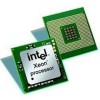Intel X5472 Data Sheet - Page 22
Front Side Bus Signal Groups
 |
UPC - 735858201551
View all Intel X5472 manuals
Add to My Manuals
Save this manual to your list of manuals |
Page 22 highlights
Quad-Core Intel® Xeon® Processor 5400 Series Electrical Specifications The TESTHI signals must use individual pull-up resistors as detailed below. A matched resistor must be used for each signal: • TESTHI10 - cannot be grouped with other TESTHI signals • TESTHI11 - cannot be grouped with other TESTHI signals • TESTHI12 - cannot be grouped with other TESTHI signals 2.7 Front Side Bus Signal Groups The FSB signals have been combined into groups by buffer type. AGTL+ input signals have differential input buffers, which use GTLREF_DATA and GTLREF_ADD as reference levels. In this document, the term "AGTL+ Input" refers to the AGTL+ input group as well as the AGTL+ I/O group when receiving. Similarly, "AGTL+ Output" refers to the AGTL+ output group as well as the AGTL+ I/O group when driving. AGTL+ asynchronous outputs can become active anytime and include an active PMOS pull-up transistor to assist during the first clock of a low-to-high voltage transition. With the implementation of a source synchronous data bus comes the need to specify two sets of timing parameters. One set is for common clock signals whose timings are specified with respect to rising edge of BCLK0 (ADS#, HIT#, HITM#, and so forth) and the second set is for the source synchronous signals which are relative to their respective strobe lines (data and address) as well as rising edge of BCLK0. Asynchronous signals are still present (A20M#, IGNNE#, and so forth) and can become active at any time during the clock cycle. Table 2-6 identifies which signals are common clock, source synchronous and asynchronous. Table 2-6. FSB Signal Groups (Sheet 1 of 2) Signal Group AGTL+ Common Clock Input AGTL+ Common Clock Output AGTL+ Common Clock I/O Type Synchronous to BCLK[1:0] Synchronous to BCLK[1:0] Synchronous to BCLK[1:0] AGTL+ Source Synchronous I/O Synchronous to assoc. strobe Signals1 BPRI#, DEFER#, RESET#, RS[2:0]#, RSP#, TRDY#; BPM4#, BPM[2:1]#, BPMb[2:1]# ADS#, AP[1:0]#, BINIT#2, BNR#2, BPM5#, BPM3#, BPM0#,BPMb3#, BPMb0#, BR[1:0]#, DBSY#, DP[3:0]#, DRDY#, HIT#2, HITM#2, LOCK#, MCERR#2 Signals Associated Strobe REQ[4:0]#,A[16:3]#, ADSTB0# A[37:36]# A[35:17]# D[15:0]#, DBI0# D[31:16]#, DBI1# D[47:32]#, DBI2# D[63:48]#, DBI3# ADSTB1# DSTBP0#, DSTBN0# DSTBP1#, DSTBN1# DSTBP2#, DSTBN2# DSTBP3#, DSTBN3# AGTL+ Strobes I/O Open Drain Output CMOS Asynchronous Input Synchronous to BCLK[1:0] Asynchronous Asynchronous ADSTB[1:0]#, DSTBP[3:0]#, DSTBN[3:0]# FERR#/PBE#, IERR#, PROCHOT#, THERMTRIP#, TDO A20M#, FORCEPR#, IGNNE#, INIT#, LINT0/INTR, LINT1/NMI, PWRGOOD, SMI#, STPCLK# 22















